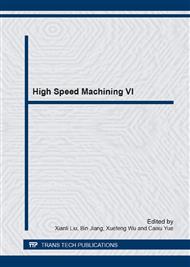p.363
p.368
p.374
p.380
p.385
p.390
p.394
p.398
p.402
DEM Simulation of Ceramic Tool Abrasion in Machining Superalloy
Abstract:
The discrete element method (DEM) model which describes the friction and abrasion behavior of the interface between Sialon ceramic tool and superalloy chip in machining were established, effects of cutting speed and depth of cut on tool abrasion were numerically investigated. The abrasion behaviors of the Sialon ceramic tool mainly appear in terms of abrasive wear, fatigue wear, adhesion wear and diffusion wear. The DEM simulation results show that, within a certain range, the higher cutting speed effectively results in the slighter wear of Sialon ceramic tools, meanwhile the deeper depth of cut leads to more serious tool wear. It is further validated that discrete element method is feasible to simulate the tool wear behavior.
Info:
Periodical:
Pages:
385-389
Citation:
Online since:
July 2014
Authors:
Price:
Сopyright:
© 2014 Trans Tech Publications Ltd. All Rights Reserved
Share:
Citation:


